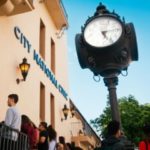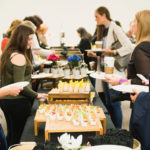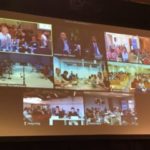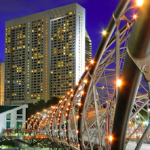
From the World Economic Forum, held each year in Davos, Switzerland, to the annual TED conference in Vancouver, there’s no shortage of international meetings where elite presenters speak to audiences whose own credentials have been thoroughly vetted before they are allowed admittance.
It’s doubtful, however, that in terms of exclusivity — not to mention sheer brainpower — any other event equals the Lindau Nobel Laureate Meetings, which annually bring the world’s most eminent scientists together with the most promising young researchers to meet in Lindau, a town and small Bavarian island in southern Germany’s Lake Constance. The 64th Lindau Nobel Laureate Meeting, held this year from June 29 to July 4, featured 37 Nobel laureates in the fields of medicine and physiology and 600 scientists under the age of 35, who came from more than 80 countries and were selected from among thousands of young scientists nominated to attend.
Unlike medical congresses where attendees are laser-focused on the latest publications and clinical trial results, the primary purpose of the Lindau meeting is the open exchange of ideas between generations and cultures. The laureates don’t just pop in to deliver talks, according to Klas Karre, a Swedish immunologist who served as the meeting’s scientific chairman, but rather help make the meeting a place where young scientists “can meet their role models on a personal level.” Added Countess Bettina Bernadotte of Wisborg, president of the Council for the Lindau Nobel Laureate Meetings, which along with the Foundation Lindau Nobelprizewinners Meetings at Lake Con-stance, organizes the conferences: “To inspire, motivate, and connect promising young scientists is the core concern” of the meetings.
HISTORY IN THE MEETING
That goal — connecting scientists across borders — was the original aim of the meeting when it was conceived in 1950 by two German physicians from Lindau with the support of the late Count Lennart Bernadotte, Countess Bettina’s father. The doctors, Franz Karl Hein and Gustav Parade, proposed that a medical conference to which they would invite international specialists be held in Lindau as a way to end the isolation that German scientists found themselves facing at the end of World War II. The count’s family connections — he was the grandson of Sweden’s King Carl Gustaf, who first awarded the Nobel Prizes in 1901 — might help convince Nobel laureates to attend, Hein and Parade reasoned. Their strategy worked: Seven laureates — from Denmark, Sweden, the United States, Switzerland, and Germany — and 400 physicians attended the first meeting. Within two years, students began to attend.
Since then, the meetings have continued despite wars, international crises, and shifting political alliances among the nations that the laureates and scientists call home. In the early, immediate post–World War II history of the program, some laureates, or combinations of laureates, were considered too politically sensitive to be invited, according to Wolfgang Huang, director of the executive secretariat of the Lindau Nobel Laureate Meetings — such as certain Jewish and German laureates, or those involved in atomic-bomb research.
“Those times are actually over, fortunately,” said Huang, speaking with Convene over coffee during this year’s meeting at Inselhalle, the conference center on the north end of the island that hosts the program. Conflicts, of course, still exist — between Israel and Palestine, China and Taiwan, India and Kashmir. “Yes, we do see that,” Huang said. “We invite all of them.”
Meanwhile, the importance of international collaboration to advance scientific knowledge has grown sharply in recent decades. The Organisation for Economic Co-operation and Development, based in Canada, has reported that the number of scientific articles published by a single author decreased by 45 percent between 1995 and 2007. During that time, the number of scientific articles published with international co-authorship increased by 409 percent.
Today, the challenge at Lindau is not in attracting participants but in accommodating all of its superstar presenters. “It goes up, actually, from year to year,” Huang said. The increase sometimes has been dramatic — the 37 laureates at this summer’s meeting represented a 60-percent increase from 2011, when 23 laureates attended.
In addition to the original Lindau Nobel Laureate Meeting focusing on medicine and physiology, dating back to 1951, organizers have added another gathering, the Lindau Meeting on Economic Sciences, which was held in Lindau last month for the fifth time. The program also reflects a growing trend toward interdisciplinary collaboration: Once every five years, Nobel laureates and young scientists from all disciplines are invited to meet in Lindau. In 2010, the last year the interdisciplinary meeting was held, 59 laureates attended. When it’s held next year, Huang expects to host 80 laureates. For the annual meeting, “the main constraint is, how do you fit all of them into a week’s program?” Huang said cheerfully. “It’s close to impossible now, and if there were 10 more, I don’t know what we’d do.”
Considering that Lindau — situated in a scenic little pocket between Germany, Austria, and Switzerland — is popular with tourists, booking hotels in the summer has often been a challenge. But since Huang can’t imagine a scenario that would include turning down a Nobel laureate who wanted to attend, he said, “We would come up with something.”
FREEDOM OF SPEECH
One of the defining characteristics of the Lindau Nobel Laureate Meetings is that the laureates deliver 30-minute lectures, during which they’re free to talk about whatever they like. “Exactly what instructions would you give to a Nobel laureate?” was a rhetorical question asked during this year’s opening ceremony.
In fact, Huang and his colleagues had considered giving the laureates a list of guidelines similar to one that TED speakers receive. (“Thou Shalt Not Simply Trot Out Thy Usual Shtick,” reads the first “TED Commandment.”) “Some of the presentations, and the way they are presented, are very traditional,” Huang said. “There is not a lot of interaction going on. We asked ourselves, ‘Should we try to influence that? Should we look at what the TED conference is doing and do something similar?’ And we decided not to do it. We wanted to be authentic. I have attended TED conferences myself, and I love them. It is a great concept — but it is not what we are doing here.”
Although many of the laureates use their time onstage to talk about their current research, or about the work that led to their Nobel Prizes, others don’t. For example, German laureate Peter Grünberg, who won a Nobel Prize in physics for his work in the field of magnetoresistance, likes to talk about the physical fundamentals of harmony in music, “which is quite fun,” Huang said. “It is about inspiration, about finding new ways of thinking.”
The meeting’s plenary sessions and large social functions, including the welcoming ceremony and dinners, are held in Inselhalle, whose main hall can accommodate a thousand people. Three smaller rooms accommodate fewer than 100 people each, a combination “that does not make sense for modern conferences,” Huang said.
Plans are underway to renovate and significantly expand Inselhalle, with more meeting rooms, a larger foyer, and greater food-and-beverage capacity. The expanded center is expected to be complete in 2017.
The lack of space at Inselhalle means that many events, including master classes, which are open only to the laureates and small groups of young scientist participants, are held in venues scattered around the small island. To get to these places — which include a 15th-century town hall, the city’s theater, and a top-floor meeting room at the charming Bayerischer Hof hotel on Lindau’s boardwalk — participants walk along curved, cobbled lanes in the medieval Old Town. (I stayed at Bayerischer Hof hotel as a guest of the German Convention Bureau, which sponsored my trip)
Even when Inselhalle’s capacity is increased, Huang expects that the “parallel” venues will still be used. “It is part of the spirit [of the meeting],” he said, “that you send people out to the city and that they explore this small island.”
City venues are also used as the setting for a series of topical sponsored “science breakfasts,” analogous to satellite symposiums. Sponsors can’t talk about their products or services, but instead support discussions on “science and society” topics. The forums also offer additional opportunities for the young scientists and Nobel laureates to talk to one another.
On Monday morning, the first full day of the meeting, I met Tracy Norman, a Ph.D. candidate at the Georgia Institute of Technology, at a “Women in Science” breakfast, held to discuss how to increase the number of women at the highest levels of the academic sciences.
The day before, Norman had texted her boyfriend — kidding, she thought — that she planned to have lunch with one of her heroes, astrophysicist Brian Schmidt, who was awarded the Nobel Prize in 2011 for his work in discovering the accelerating expansion of the universe. In fact, a delighted Norman had just talked with Schmidt, over fruit and croissants.
‘A ONCE-IN-A-LIFETIME EXPERIENCE’
Before Huang took the job coordinating the Lindau Nobel Laureate Meetings, he worked as the head of conference logistics for K.I.T. Group, organizing large global medical conferences. “It was a great job,” Huang said, but he grew tired of all the long flights it required. “I was traveling around the world all the time,” he said. “Maybe I should be saying that it was so interesting to travel around the world all the time, and see so many places. And it was interesting — I loved it. But after a couple of years, it is tiring.” The other thing, “of course,” Huang said, “is that I did like what they do here.”
One of the other key differences between Huang’s job planning large international conferences and the Lindau Nobel Laureate Meetings is that, unless they are part of a small number of alumni who are invited back to the meetings at the peak of their careers, non-Nobel laureate scientists can attend only once. “We put a lot of time and energy into really making this a once-in-a-lifetime experience, at least for the young people,” Huang said. “And a very nice and treasurable experience for the Nobel laureates.”
When you’re planning a 10,000-person medical meeting, it can’t be a goal to make it a once-in-a-lifetime experience for everyone. “Especially with the large conferences, of course, attendees become kind of abstract,” Huang said. “You cannot think individually about 10,000 people.” That’s not true of the Lindau meetings, which many Nobel laureates attend more than once, if not multiple times. Huang’s staff knows the hotels that certain laureates prefer, and also which hotels are best suited to attendees from particular countries.
A small number of attendees stay with area host families, and Huang’s staff makes those matches thoughtfully, he said. Attendees initially were housed with host families for pragmatic reasons — a lack of space — but the program continues to grow because it’s so popular. Even when hotel rooms are in ample supply, as they were this year, “we continue it, because we get such an overwhelming feedback,” Huang said. “We started with [about] 10 host families and now we are at 50.”
There’s another aspect to the home stays, related to the work of the American Nobel laureate Peter Agre, who is associated with the Center for Science Diplomacy, established by the American Association for the Advancement of Science (AAAS). “The idea of the center, as the name says, is that science collaboration can have a peaceful effect or positive effect on the relations between nations, countries, and so on,” Huang said. “I think that the idea of host families is a very small piece of this overall idea. We hear a lot of stories. Families here in Lindau say, ‘Oh, we have just been on holidays in the U.S., and we visited the young lady that we had in our family when she was in Lindau.’ And we have stories of families that are invited to weddings in India and things like that.”
LEDERHOSEN? SERIOUSLY?
Given the dazzling academic credentials of virtually every scientist-participant, the simplicity of the meeting’s social program — with the exception of outstanding musical performances — is in almost inverse proportion to the complexity of its content. For example, at the International Dinner, held the second evening of the meeting, Countess Bernadotte led participants in what is known at the meeting as a “Polonaise Dance” — male participants line up randomly on one side of the hall and female participants line up on the other, and they meet in the middle, where the couples are required to dance with one another.
“When I came here and heard about it, I thought, Oh, come on, guys. You cannot do this. You cannot be serious,” Huang said. “But then I saw it for the first time, and since then, I am convinced. As long as I will be here, we are going to do it. It is an awkward situation for everyone. That is part of the fun. And that brings people together.”
Similarly, a dinner featuring Bavarian music and folk dance, with a Bavarian buffet, is held on the last evening. “To some extent it is a cliché,” Huang said. “We like it.” Well, almost everyone likes it. “We frequently get comments afterwards from the Germans who are not from Bavaria who say, ‘Come on, guys. Lederhosen and beer and all that stuff? You cannot really be serious.’ But we are in Bavaria, and it is fun.”
The casual sociability is popular with the Nobel laureates as well as the students. “They, too, are convinced of the idea and the informal way that we organize the dialogue with the young people,” Huang said. “If you are a successful professor and a Nobel laureate, you can start getting detached from the people working in your own lab. You are attending so many conferences, and talking to so many people. And then if they are directors of institutes, there are so many business things they need to take care about. And there is less and less time for their own research and for contact with their own young students. And I think this week in Lindau is [like] taking a week off from the normal business. Not as holidays. They spend it for the dialogue with the young people.”
This year the week ended, as it has since 1951, with a daytrip by boat from Lindau to the Isle of Mainau, a park-like island complete with castle and extensive palace gardens — the former property of Count Lennart Bernadotte, the Lindau Nobel Laureate Meetings founder. By then, the star-struck young scientists who had arrived in Lindau just days before were completely at ease, said Ingrid-Anna Augustin, a local journalist who covers the meetings. At the beginning of the week, the young scientists are “a little bit shy” with each other and the Nobel laureates, she said. By the end, “it’s as if they knew each other for years. It’s like a family that comes together.”
UNBURIED TREASURE
Among the many farsighted moves made by founders of the Lindau Nobel Laureate Meetings, there’s one that stands out, according to Wolfgang Huang, the director of the executive secretariat, which coordinates the meetings. Organizers began filming the conference content in 1952, the second year that the program was held. “Everyone is doing it now,” Huang said, “but who was recording the lectures back in 1952?”
The early recordings were forgotten for decades. They were only found a few years ago, when the offices of the Council for the Lindau Nobel Laureate Meetings were renovated. “And then we realized what a treasure trove this actually was,” Huang said.
The council recovered approximately 800 tapes, and is working on digitizing about half. They’re being edited to make the content accessible to the public, not just physically but conceptually. “We realize that, of course, you can put a 19-minute lecture by German physicist Werner Heisenberg online,” Huang said, “but this is really tough stuff.” The videos are available at mediatheque.lindau-nobel.org



